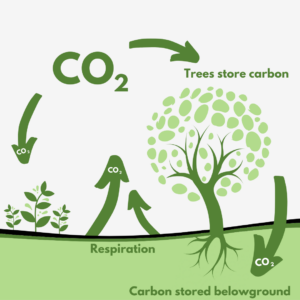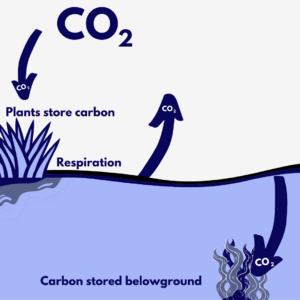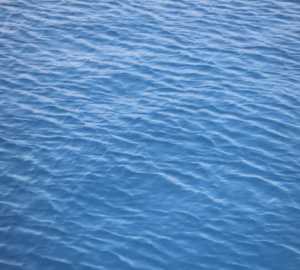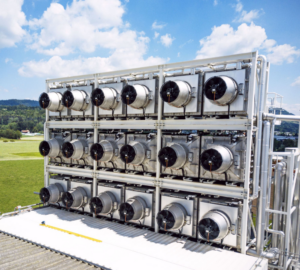
CARBON SEQUESTRATION
What is Carbon Sequestration?
Carbon Sequestration is the natural process of capturing and storing carbon dioxide (CO2) from the atmosphere in natural lands that act as sinks. The Intergovernmental Panel on Climate Change defines a sink as any process, activity or mechanism that removes a greenhouse gas or aerosol, or a precursor of a greenhouse gas or aerosol, from the atmosphere. New Jersey’s natural lands such as forests and tidal wetlands lands act as natural sinks, and in 2019 they absorbed 8.1 million metric tons of CO2e from the atmosphere. These natural lands will need to be preserved and enhanced to maximize the carbon sequestration benefits that can be acquired through them.
Blue Carbon
Blue Carbon refers to organic carbon that is captured and stored by the oceans and coastal ecosystems, particularly by vegetated coastal ecosystems, seagrass meadows, tidal marshes, and mangrove forests. Coastal ecosystems such as tidal marshes and seagrass meadows sequester more carbon per unit area than terrestrial forests and the carbon can be stored for millennia.
It is estimated that New Jersey currently has 191,178[1] acres of blue carbon resources, but , but modeling based on NOAA’s sea-level rise predictions of 1 and 2.5 feet by 2050, suggests that the state’s tidal salt marsh could decline between 5 and 9% by 2050 due to sea level rise. Rising seas can, however, create new salt marshes where “marsh migration” pathways are protected and left open. Tidal salt marsh surface can rise in relation to sea-level through the process of vertical accretion of sediment and organic matter. Ecological solutions that restore tidal flows to salt marshes that have been disconnected from the ocean enable vertical accretion, reduce methane emissions, and should be prioritized for state action.
[1] Based on land cover calculations completed by the NJDEP Bureau of GIS, January 2020
Oceans and Carbon Sequestration
The world’s oceans currently absorb just under one-third of anthropogenic Carbon Dioxide (CO2) emissions, which is contributing to a rise in ocean acidification and making it more difficult for organisms like oysters and corals to build shells.
Ocean Acidification is the process by which the addition of CO2 acts to increase seawater acidity and lower pH. Carbon Dioxide dissolves rapidly in seawater, changing its chemistry. As the ocean absorbs an increasing amount of CO2, it also reduces the concentration and availability of the carbonate ions, harming marine organisms. Many marine organisms rely on carbonate ions to develop protective shells and skeletons.
While increased ocean exposure to atmospheric CO2 is the primary driver of ocean acidification in ocean waters globally, several drivers in nearshore coastal shelves and estuaries are attributed to ‘coastal acidification’ and include inputs of nutrients from fertilizers, wastewater treatment effluents, and pollutants from developed land use patterns.
State Action on Carbon Sequestration & Ocean Acidification
Removing and sequestering carbon from the atmosphere is integral to reducing greenhouse gas emissions that are threatening our climate. In recognition of the vital role that carbon sequestration plays in achieving the state’s greenhouse gas reduction goals, the Department of Environmental Protection has:
- Developed a series of Carbon Sequestration recommendations, as part of the Global Warming Response Act 80×50 Report
- Launched a Natural Climate Solutions Grant program to fund on-the-ground implementation of projects that create, restore, and enhance New Jersey’s natural carbon sinks;
- Committed to develop a Natural and Working Lands Strategy, to holistically center statewide land use management decisions on carbon sequestration, climate resilience, and other complimentary environmental and economic benefits; and
- Embarked on the development of a Coastal Ecological Restoration and Adaptation Plan (CERAP), which will identify areas for ecological projects that increase community resilience, ecosystem health, and carbon sequestration.
Further, acknowledging that while New Jersey has not tangibly realized the potential impact of Ocean Acidification on its coastal resources, it is an emerging threat for the state’s commercial fisheries and shellfisheries industries and its growing aquaculture sector, thus the state has:
- Joined the Ocean Acidification Alliance
- Developed an Ocean Acidification Monitoring Network
- Commissioned a report on Ocean Acidification Impacts in New Jersey
What is Carbon Capture, Utilization and Storage?
Carbon Capture, Utilization, and Storage or CCUS is an umbrella term for various advanced technologies that remove carbon dioxide from the waste streams of industrial processes or from the atmosphere. CCUS technologies target CO2 removal from large point sources, such as gas-powered plants, coal powered plants, cement plants, natural gas processing plants, and ammonia plants. There are also technologies to capture CO2 directly from the air. Once captured, the CO2 can either be stored at least 1 kilometer underground, or it can be repurposed into new products such as fuel, concrete, and alcohol.
There are five main CCUS technologies:
- Solvents and Sorbents: The process of passing the CO2 gas mixture in contact with a liquid solvent or solid sorbent that selectively “grabs” the CO2 from the gas mixture.
- Oxy-combustion: A gas separation process that involves filtering O2 from the air prior to burning the fuel so that the byproduct (CO2 and water) can be separated.
- Direct Air Capture: A four-step process that uses chemical reactions to capture CO2 from the atmosphere. Only targets atmosphere with CO2 concentration of 0.04%
- Membranes: Captures carbon dioxide by putting the gas stream containing CO2 in contact with specially engineered materials called membranes.
- Cryogenic Distillation: The process of cooling a CO2 gas mixture until it liquefies, then allowing the liquid to warm to the boiling points of individual components to produce a purified gas stream which is then cooled down to very low temperatures until the mixture solidifies into dry ice which the CO2 can then be separated.
Image Source: IEA. www.iea.org/reports/about-ccus
References
IPCC (2018). Annex I: Glossary [Matthews, J.B.R. (ed.)]. In: Global Warming of 1.5°C. An IPCC Special Report on the impacts of global warming of 1.5°C above pre-industrial levels and related global greenhouse gas emission pathways, in the context of strengthening the global response to the threat of climate change, sustainable development, and efforts to eradicate poverty. Retrieved from https://www.ipcc.ch/sr15/chapter/glossary/
Pidgeon, E. (2009). Carbon Sequestration by Coastal Marine Habitats: Important Missing Sinks. In D. G. Laffoley, The Management of Natural Coastal Carbon Sinks. IUCN, Gland.




